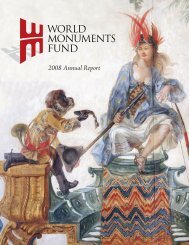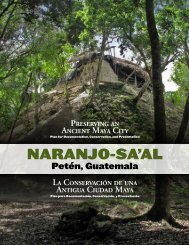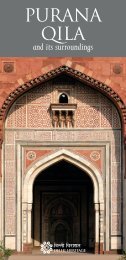Summary of the Proceedings and Papers Presented at - World ...
Summary of the Proceedings and Papers Presented at - World ...
Summary of the Proceedings and Papers Presented at - World ...
You also want an ePaper? Increase the reach of your titles
YUMPU automatically turns print PDFs into web optimized ePapers that Google loves.
Un Piano per Pompei (A Plan For Pompeii) was <strong>the</strong><br />
title <strong>of</strong> an interdisciplinary project undertaken by<br />
<strong>the</strong> Soprintendenza Archeologica di Pompei in<br />
1997, made possible due to initial resources provided<br />
by <strong>the</strong> <strong>World</strong> Monuments Fund. Completed in 2002,<br />
<strong>the</strong> project’s aim was to draw up a technical instrument th<strong>at</strong><br />
could subsequently be used to manage <strong>the</strong> many activities<br />
th<strong>at</strong> contribute to <strong>the</strong> main objective <strong>of</strong> preserving Pompeii.<br />
Our hypo<strong>the</strong>sis, based on <strong>the</strong> experience gained during<br />
<strong>the</strong> years we spent working in Pompeii, is th<strong>at</strong> conserv<strong>at</strong>ion<br />
can only be really effective if it is flanked by parallel design<br />
activities th<strong>at</strong> involve modific<strong>at</strong>ion <strong>and</strong> change.<br />
Conserv<strong>at</strong>ion <strong>and</strong> change are, according to this perspective,<br />
two sides <strong>of</strong> <strong>the</strong> same activity: th<strong>at</strong> <strong>of</strong> project development.<br />
In Pompeii, <strong>the</strong> project has been developed with<br />
sustainability in mind, hence <strong>the</strong> definition <strong>of</strong> “Sustainable<br />
Pompeii”. This meant coming up with a viable development<br />
plan so th<strong>at</strong> Pompeii may continue to be used by millions<br />
<strong>of</strong> visitors in <strong>the</strong> future—<strong>the</strong>reby fulfilling its cultural role in<br />
today’s society, while <strong>at</strong> <strong>the</strong> same time, its m<strong>at</strong>erial aspects<br />
may be conserved, <strong>and</strong> in some instances even revitalized,<br />
so th<strong>at</strong> it may survive well into <strong>the</strong> future.<br />
This meant looking <strong>at</strong> a bigger picture than <strong>the</strong> one normally<br />
considered by archaeologists; in o<strong>the</strong>r words, we exam-<br />
italiano<br />
Sustainable Pompeii -<br />
Conserv<strong>at</strong>ion, Fruition <strong>and</strong> Designing<br />
New Architectural Interventions<br />
by Giovanni Longobardi<br />
ined subjects such as changes in <strong>the</strong> surrounding l<strong>and</strong>scape,<br />
<strong>and</strong> carried out a detailed study <strong>of</strong> tourists’ movements <strong>and</strong><br />
p<strong>at</strong>terns <strong>of</strong> visit<strong>at</strong>ion th<strong>at</strong> have changed significantly over<br />
<strong>the</strong> last 25 years.<br />
From this broader perspective, <strong>the</strong> problem <strong>of</strong> conserving<br />
Pompeii becomes more complic<strong>at</strong>ed because <strong>of</strong> <strong>the</strong> interactions<br />
<strong>of</strong> “external” factors, which have a direct impact<br />
on <strong>the</strong> site <strong>and</strong> whose effects must be properly evalu<strong>at</strong>ed.<br />
“A Plan for Pompeii” has <strong>the</strong>refore resulted in a project<br />
th<strong>at</strong> aims to reconsider <strong>the</strong> rel<strong>at</strong>ionship between <strong>the</strong> archaeological<br />
site <strong>and</strong> <strong>the</strong> contemporary city th<strong>at</strong> has grown<br />
up around it, in an <strong>at</strong>tempt to connect <strong>the</strong> elements <strong>of</strong> <strong>the</strong>se<br />
two entities th<strong>at</strong>, in 250 years <strong>of</strong> Pompeii’s modern history,<br />
did not have <strong>the</strong> chance to develop links.<br />
The project is already being implemented with <strong>the</strong> opening<br />
<strong>of</strong> a new entrance for visitors, more or less halfway between<br />
<strong>the</strong> two existing ones. This entails making use <strong>of</strong> a large<br />
green area (ab<strong>and</strong>oned during <strong>the</strong> last twenty years) th<strong>at</strong> will<br />
act as a link between <strong>the</strong> ancient <strong>and</strong> <strong>the</strong> modern towns.<br />
From a superficial point <strong>of</strong> view, <strong>the</strong> site will gain a new<br />
identity, but this should not be seen as <strong>the</strong> only effect <strong>of</strong><br />
this intervention: <strong>the</strong> central loc<strong>at</strong>ion <strong>of</strong> this new entrance<br />
reduces <strong>the</strong> distance between <strong>the</strong> two towns <strong>and</strong> cre<strong>at</strong>es<br />
an ideal opening in <strong>the</strong> archaeological boundary where past<br />
<strong>and</strong> present meet <strong>and</strong> mingle as complementary spaces.
















